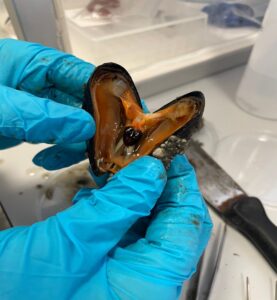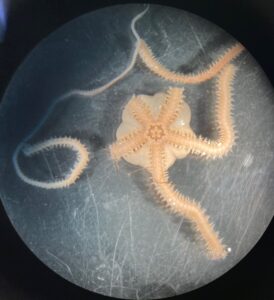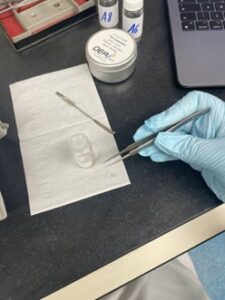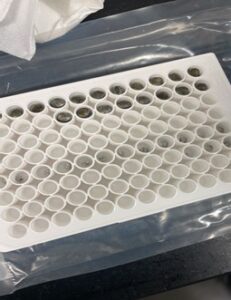Author: Emily Kovnatore, BSc Chemistry, University of Aberdeen
Project: Trophic structure and functioning of the macrofauna community in Loch Creran investigated via dual stable isotope labelling experiments
Supervisor: Ursula Witte & Anton Kuech, School of Biological Sciences, University of Aberdeen.
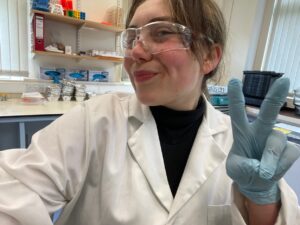
Hello, I’m currently a BSc Chemistry student at the University of Aberdeen, in my final year. A few days before my final exam in May, I received an email advertising several placements. One of them particularly caught my attention when I discovered it was related to marine biology. During my third year, I studied environmental chemistry, which piqued my interest in this area. When I saw the opportunity to apply for this placement, I felt excited. I wanted to explore something different and see if marine biology might be a future career path for me, even though I had limited prior knowledge in the field. The project that intrigued me was titled: ‘Trophic structure and functioning of the macrofauna community in Loch Creran investigation via dual stable isotope labelling experiments.’
The primary goal of this research was to gain a deeper understanding of how the macrofauna community in Loch Creran interacts, functions, and is structured in terms of feeding relationships and ecological roles. This was achieved through stable isotope labelling experiments (SIA) involving 13C and 15N elements, a classic method for tracing food sources within the microfauna community. SIA serves as a kind of ‘fingerprint’ that helps scientists answer questions about food web dynamics, carbon and nutrient cycling, migration patterns of the macrofauna community, and the impact of environmental changes on the ecosystem. The research was divided into smaller objectives, and during my time with the team, my focus was on:
During the first week of my placement, the team and I embarked on a field trip to the Ythan estuary to collect macrofauna species, including crustaceans, bivalves, gastropods, polychaete crabs, jellyfish, and brittlestar, some examples of species can be seen in photos below. We conducted SIA to ensure the instruments were providing accurate results before analysing Loch Creran samples.
For the next 3-4 weeks, my daily tasks in the lab included analysing macrofauna species from the Ythan estuary. This involved taking pictures, identifying specimens, drying them in the oven, weighing them, acidifying, weighing again, drying once more, bull milling, and packing them into small circles for subsequent 13C and 15N SIA. I can confidently say that I gained proficiency in the skill of weighing, as it played a significant role in our research. 😀
The second part of the project involved analysing samples from Loch Creran, following a similar process to what we did with the Ythan samples. However, in this case, we needed to be more caution and use specialized equipment to prevent any contamination. Unfortunately, my placement concluded before we received the results of the analysis, but I did get a chance to look through some data from the SIA conducted on the Ythan estuary samples.
During my internship, I participated in weekly meetings with the supervisor, PhD and master’s students, and a technician. These meetings typically revolved around discussing the progress made during the previous week, addressing general queries, and engaging in discussions related to research papers. This experience was both insightful and valuable, as it provided me with a first-hand look at how a research team operates and allowed me to immerse myself in a professional atmosphere. Among these activities, I particularly enjoyed our discussions on research papers, as they consistently expanded my knowledge base, leaving me with newfound insights after each meeting.
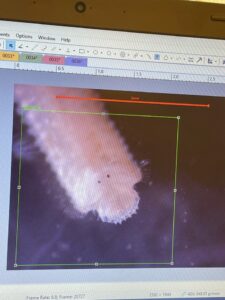
During the 10-week placement, I devoted considerable thought to my future options. This experience helped me to construct a potential path for my future. I must admit, I thoroughly enjoyed learning about macrofauna species, some of which were super cute and never failed to bring a smile to my face, like this charming polychaete: Eumida genus that reminds me of a baby hippo (left).
I am extremely grateful to the PhD student with whom I primarily collaborated during my placement. He patiently taught me everything from the start and was always happy to answer any questions I had. Both he and another PhD student offered valuable insights and suggestions for potential career paths in marine industry. During the placement, I worked alongside with another REP student on the same project, and we have since become good friends. So, not only did I gain valuable experience, but I also formed meaningful connections with great people.
After the placement experience prompted me to reconsider my future path, my next step involves looking more into job opportunities in the field of marine chemistry and potentially pursuing a master’s degree in this area.


